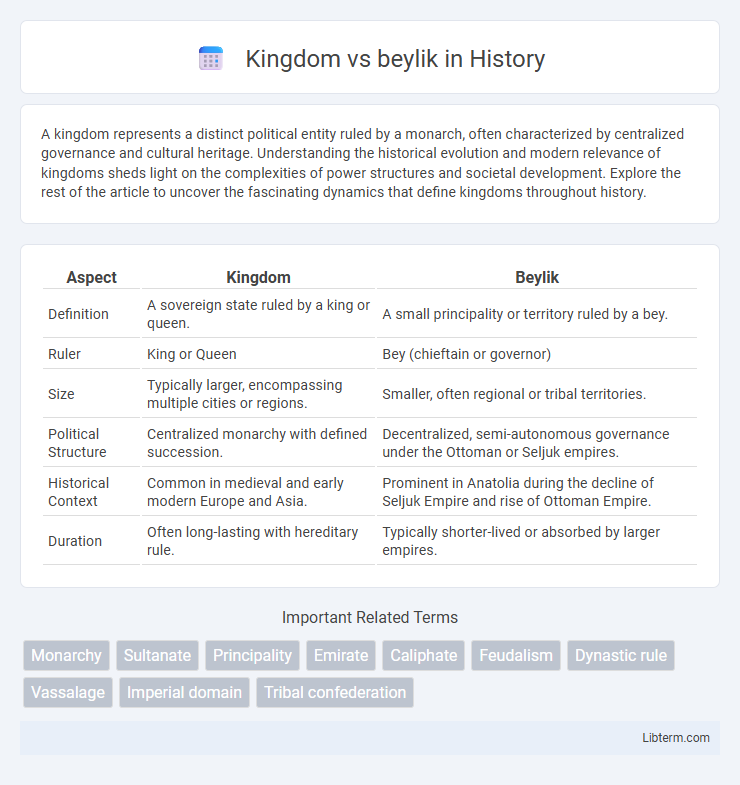A kingdom represents a distinct political entity ruled by a monarch, often characterized by centralized governance and cultural heritage. Understanding the historical evolution and modern relevance of kingdoms sheds light on the complexities of power structures and societal development. Explore the rest of the article to uncover the fascinating dynamics that define kingdoms throughout history.
Table of Comparison
| Aspect | Kingdom | Beylik |
|---|---|---|
| Definition | A sovereign state ruled by a king or queen. | A small principality or territory ruled by a bey. |
| Ruler | King or Queen | Bey (chieftain or governor) |
| Size | Typically larger, encompassing multiple cities or regions. | Smaller, often regional or tribal territories. |
| Political Structure | Centralized monarchy with defined succession. | Decentralized, semi-autonomous governance under the Ottoman or Seljuk empires. |
| Historical Context | Common in medieval and early modern Europe and Asia. | Prominent in Anatolia during the decline of Seljuk Empire and rise of Ottoman Empire. |
| Duration | Often long-lasting with hereditary rule. | Typically shorter-lived or absorbed by larger empires. |
Introduction: Defining Kingdom and Beylik
A kingdom is a sovereign state ruled by a king or queen with centralized authority over a defined territory, often characterized by hereditary leadership and established institutions. A beylik, originating from Turkish history, refers to a smaller principality governed by a Bey, typically possessing localized power and operating within a larger empire or fragmented region. The distinction lies in the scale of governance, sovereignty, and political influence, with kingdoms representing more expansive and formalized rule compared to the semi-autonomous nature of beyliks.
Historical Origins of Kingdoms and Beyliks
Kingdoms originated as centralized states ruled by monarchs, often emerging in ancient civilizations such as Mesopotamia, Egypt, and Europe, characterized by hereditary succession and formalized state structures. Beyliks, on the other hand, were small principalities established primarily in the medieval Islamic world, especially Anatolia, during the decline of the Seljuk Empire, governed by beys who maintained semi-autonomous control under larger empires. The historical origins of kingdoms reflect the development of early statehood and centralized authority, while beyliks represent a fragmented political system shaped by regional power dynamics and tribal leadership.
Political Structures and Hierarchies
Kingdoms featured centralized political structures ruled by monarchs who held supreme authority, supported by a hierarchical nobility and administrative officials. Beyliks operated with more decentralized governance, often led by local chieftains or beys, whose power was balanced by tribal leaders and councils. The hierarchical organization in kingdoms emphasized rigid social stratification, while beylik political systems allowed for flexible alliances and shared leadership among influential clans.
Territorial Control and Expansion
Kingdoms typically exercised centralized territorial control through a monarch who held supreme authority over a defined and often extensive realm, enabling organized expansion through military conquest and strategic alliances. Beyliks, on the other hand, were smaller, more fragmented principalities governed by beys with localized power, focusing on maintaining control over limited territories and engaging in regional conflicts to gradually expand their influence. The hierarchical structure of kingdoms allowed for more coordinated administration of diverse lands, whereas beyliks relied on flexible, often decentralized governance to adapt to shifting political landscapes during territorial expansion.
Governance and Administration
Kingdoms typically maintained centralized governance with a monarch holding supreme authority, supported by a structured bureaucracy that managed administration across vast territories. Beyliks operated under a more decentralized system, where local beys exercised significant autonomy, often balancing tribal leadership with Islamic administrative principles. The governance of kingdoms was characterized by formal legal codes and institutionalized offices, whereas beyliks relied on flexible, often personalized rule adapting to regional and tribal dynamics.
Military Organization and Strategies
Kingdoms typically maintained centralized military organizations with standing armies led by professional commanders, enabling rapid mobilization and coordinated strategies across vast territories. Beyliks, often smaller and semi-autonomous principalities, relied on decentralized forces composed of tribal warriors and local militias, employing guerrilla tactics and swift cavalry maneuvers suited for regional defense and raids. The contrasting military structures influenced strategic approaches, with kingdoms favoring large-scale battles and fortified borders, while beyliks emphasized mobility and flexible combat operations.
Economic Systems and Resource Management
Kingdoms typically employed centralized economic systems with state-controlled taxation and resource allocation, enabling large-scale infrastructure projects and sustained military funding. Beyliks operated more decentralized economies, relying heavily on local trade networks, agricultural production, and artisan guilds to manage resources. Resource management in kingdoms emphasized extraction and distribution through bureaucratic institutions, whereas beyliks utilized flexible, community-based approaches to optimize local resources and regional commerce.
Cultural Impact and Social Organization
Kingdoms typically exhibited centralized social organization with hierarchical structures led by monarchs, fostering unified cultural development reflected in cohesive art, religion, and language. Beyliks, smaller principalities often governed by beys, displayed more localized social systems that allowed diverse cultural expressions and flexible social organization adapting to regional traditions. The cultural impact of kingdoms resulted in widespread, standardized practices, whereas beyliks promoted cultural pluralism through decentralized governance and local autonomy.
Decline, Transformation, and Legacy
Kingdoms often declined due to centralized power struggles and external invasions, whereas beyliks transformed through decentralization and local governance, adapting to shifting political landscapes. The legacy of kingdoms includes established legal codes and architectural achievements, while beyliks influenced regional culture and set foundations for future states. Both entities played crucial roles in shaping sociopolitical structures and cultural identities in medieval history.
Comparative Analysis: Kingdom vs Beylik
Kingdoms typically feature centralized authority under a monarch with formalized bureaucracies, whereas beyliks often operate as smaller, semi-autonomous principalities led by beys with localized governance structures. Kingdoms possess more extensive territorial control and resources, enabling stronger military and administrative capacities, in contrast to beyliks' limited reach and reliance on tribal or clan-based alliances. The sociopolitical organization of kingdoms favors hierarchical stability and long-term dynastic continuity, while beyliks exhibit flexible, adaptive governance suited to regional power dynamics and external pressures.
Kingdom Infographic

 libterm.com
libterm.com